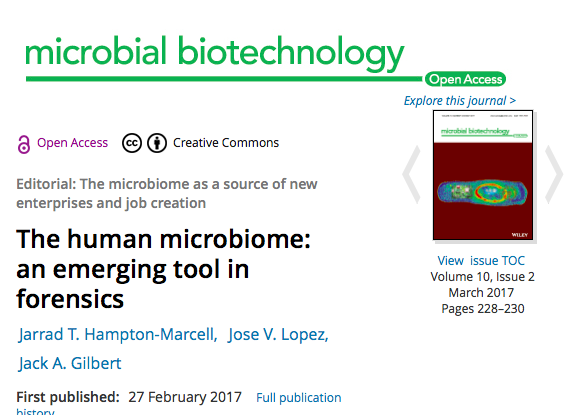
I have personally been interested in microbial forensics of various kinds for quite a while (I worked at TIGR for many years and was peripherally involved in some of the anthrax DNA sequencing and analysis there). I have even served on various working groups from the US Government discussing the potential for microbes to be used in forensics. There is actually a decent history of this for single microbial pathogens. But recently there has been expanding interest in using microbiomes – that is, communities of microorganisms, for forensics.
If you are interested in this topic I suggest you check out this new open access editorial from Jarrad Hampton-Marcell, Jose Lopez, and Jack Gilbert (for full disclosure, I have collaborated with Gilbert on some forensics related studies – and I have also argued publicly and privately with Jack about the need for caution in promoting microbial forensics as ready for prime time).
Some quotes below:
Interestingly, the fluctuations in the structure and composition of the microbiome may contain useful information that could also be used for forensic purposes. Host lifestyle, including diet, occupation, travel, and pharmaceutical use, can influence the composition and structure of microbiome. This suggests that profiling the microbial community in and on our body could also help to reveal details about an individual’s lifestyle (Gonzalez et al., 2016; Kuntz and Gilbert, 2017), which could represent new trace evidence.
And this one I like a lot since I believe it is still way to early to use microbiome data in criminal investigations (e.g., see this paper)
Importantly, these are just preliminary studies, and the results and conclusions cannot be used to justify the application of microbial sequencing to forensic studies. However, the statistical basis for the accurate matching of a person to their microbiota, and evidence that a residual microbial fingerprint could be used to discriminate individuals, does suggest that in the future, it may be possible to use these profiles for forensic investigations. Yet, however intimate the association, because microbial compositions can shift with environmental factors and over time, they cannot be definitively equated with the host genome pr
ofile. Therefore, a substantial amount of research is still required to prove that residual microbial fingerprints can be used as effective trace evidence
Anyway – this is worth a look.
